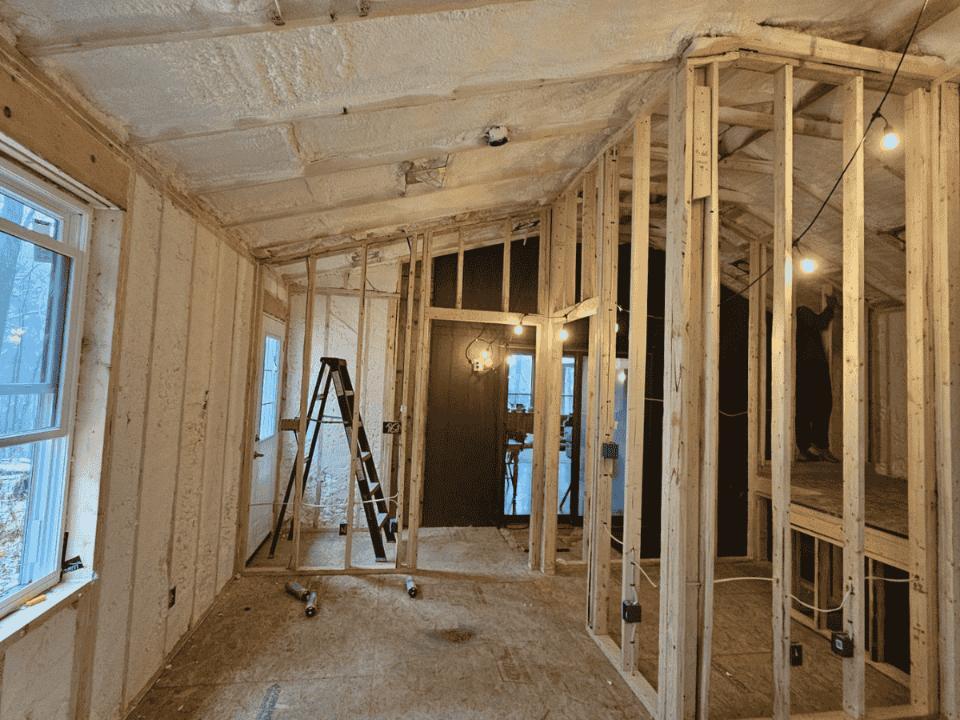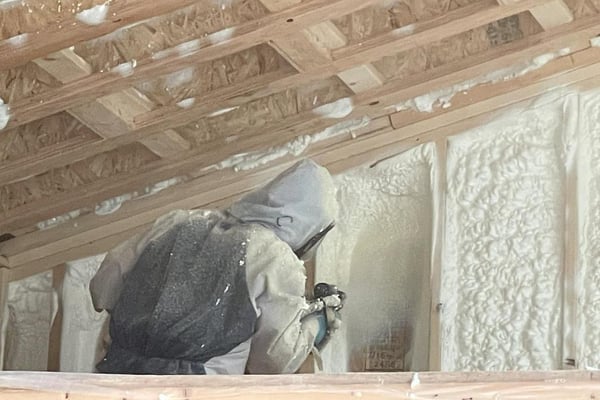What Is The Best Insulation For New Home Construction?
May 14th, 2025
6 min read

When you’re building a new house, you want things done the right way. Of course, there are times when you’ll want to cut costs or opt for something budget-friendly. But as long as you’re making an effort to construct a brand new home, you want to understand all of your options.
South Central Services has insulated hundreds of new homes near Mechanicsburg, Chambersburg, Gettysburg, and other parts of our service area. A variety of insulations can be used in a new build home, ranging in price and energy efficiency.
By the end of this article, you will know:
- What makes an insulation best for your new home
- Options for exterior wall insulation
- Options for interior wall insulation
- Options for attic and roof insulation
- Options for basement and crawl space insulation
- Options for foundation insulation
“Best” Varies By Your Budget, Goals, & Climate Zone.
No matter what product you’re researching, there are always caveats about what makes a version good, better, or best. When it comes to insulation, choosing the best product depends on three factors:
- Budget
- Goals
- Climate zone
It doesn’t matter how effective an insulation product is if you cannot afford it. When you are more budget-conscious, the best insulation delivers affordable performance.
However, the performance that you’re looking for can also impact which insulation is best. If you want your new home to be as energy-efficient as possible, then the best products have the best performance. If you’re less concerned about how high your energy costs may be, then performance won’t have as significant of an influence on your choice.
Finally, your climate zone affects your choice of insulation. A product that is best in a cold weather climate will not be best for a more moderate climate. At South Central Services, we work primarily in Climate Zone 5, which means our recommendations are tailored to the environment we work and live in.
This article will detail all the insulation options available for new homes so you can evaluate each by your budget, goals, and climate zone. Consult with an insulation contractor if you have questions about your climate zone.
Exterior Wall Insulation Options
Exterior wall insulation is vital in any home. Your exterior walls are part of your thermal envelope, making up the barrier between your inside temperatures and the weather conditions outside. Exterior walls are an area where insulation performance is more critical.
Dense Pack
.jpg?width=534&height=400&name=N95%20Dense%20Pack%20(1).jpg)
Dense pack cellulose is relatively budget-friendly, at $2 to $4 per square foot. Dense pack tightly packs loose-fill cellulose inside the wall cavities.
- R-3.8 per inch
- Airtight seal
- Sound attenuation
Dense pack can create an airtight seal, making it more energy efficient. However, it does run the risk of settling over time.
Hybrid System

Hybrid system insulation is a more affordable option for energy efficiency. Hybrid systems combine the performance of spray foam with the budget-friendliness of fiberglass batt. These systems cost between $3.50 and $6.00 per square foot.
- Airtight seal
- Vapor barrier
- Sound attenuation
Hybrid systems can provide an airtight seal and a vapor barrier. This is energy efficient and necessary for some climate zones. However, these systems must be installed by a qualified insulation contractor since they include spray foam manufacturing.
Open Cell

Open cell spray foam is a pricier option for exterior walls. Open cell costs between $1.90 and $4.00 per square foot in an exterior wall.
- R-3.7 per inch
- Airtight seal
- Sound attenuation
Open cell spray foam delivers an airtight seal and a high R-value. Open cell offers excellent insulating performance for maximized energy efficiency.
Closed Cell

Closed cell spray foam is the most expensive insulation option for exterior walls. Closed cell costs between $3.50 and $7 per square foot in an exterior wall.
- R-7 per inch
- Airtight seal
- Vapor barrier
Closed cell spray foam offers a high R-value, air barrier, and vapor barrier. Closed cell has ideal performance with excellent energy efficiency.
Interior Wall Insulation Options
Interior walls need significantly less performance than exterior walls. Interior wall insulation is most concerned with stopping sound transfer. Interior walls do not need to have energy-efficient insulation.
Fiberglass Batt
.jpg?width=533&height=400&name=Fiberglass%20Batt%20In%20Interior%20Walls%20(Gettysburg%2c%20PA).jpg)
Fiberglass batt is one of the most affordable insulation options, costing between $0.75 and $3.00 per square foot.
- R-11 to R-49
- Sound attenuation
Fiberglass batt is commonly used for interior walls and is budget-friendly.
Dense Pack

Just like with exterior walls, dense pack cellulose costs between $2 and $4 per square foot.
- R-3.8 per inch
- Sound attenuation
Dense pack cellulose is a good option for interior walls, especially if you’ve already chosen dense pack for your exterior walls.
Attic / Roof Insulation Options
Your attic is an above-grade area that faces excessive heat transfer. As the sun beats against your roof, your home can absorb a lot of heat. Your attic is also part of your thermal envelope, so it generally requires more performance from its insulation.
Blown-In Cellulose
.jpg?width=533&height=400&name=Fairfield%20PA%20Blown-In%20Cellulose%20(1).jpg)
In an attic application, blown-in cellulose costs between $1.70 and $4.00 per square foot at R-49. Blown-in is relatively budget-friendly. However, blown-in is not ideal for attics with HVAC ductwork running through them since the insulation is applied to the floor, not the rafters.
- R-3.7 per inch
We recommend pairing blown-in cellulose with an airtight seal in your attic floor. This will boost the performance of the insulation. Blown-in cellulose will need topped off over time as the product settles.
Open Cell

For an attic, open cell spray foam can cost anywhere between $2.50 and $7.50 per square foot. Open cell is versatile, allowing you to have either a vented or unvented attic. We recommend an unvented attic if you’ll have HVAC ductwork running upstairs.
Insulating the gables and underside of the roof will be more expensive than insulating the floor.
- R-3.7 per inch
- Airtight seal
Open cell is less budget conscious, but it does deliver better performance. Open cell spray foam is also long-lasting, so you won’t need to worry about replacing your attic insulation.
Closed Cell

Closed cell spray foam is the most expensive option for an attic, coming in at $5.75 to $8.75 per square foot in an attic application. Like open cell, closed cell can be sprayed on the floor or the gables and underside of the roof.
- R-7 per inch
- Airtight seal
- Vapor barrier
Closed cell spray foam offers a vapor barrier, which is necessary for some climates. Closed cell is also a permanent insulation solution and should last for the lifetime of your home.
Basement / Crawl Space Insulation Options
Not every home has both a basement and a crawl space. However, most homes do have one or the other of these areas. Basements and crawl spaces are below-grade, which means they do not have heat exchange from direct sunlight.
However, being underground, these areas face excessive moisture. Vapor barriers are key for below-grade areas, and these places are another key part of the thermal envelope.
Closed Cell & Fiberglass

For an unfinished basement, the best insulation combination is closed cell spray foam and fiberglass batt. Closed cell spray foam in the basement band boards stops cold air infiltration. The basement ceiling is filled with fiberglass batt.
Insulating the band boards usually costs between $1,300 and $3,000, while batt insulation is around $0.75 to $3.00 per square foot.
- Vapor barrier from closed cell
- Airtight seal from closed cell
- R-11 to R-49 for fiberglass batt
While unfinished basements could opt for closed cell spray foam alone, this combination is the most affordable while also delivering necessary performance.
Closed Cell Alone

Another option, ideal for finished or unfinished basements, is closed cell spray foam on the walls. Since basement walls are made up of masonry, they are best insulated with closed cell. For basement walls, closed cell spray foam costs between $2.90 and $5.25 per square foot. Insulating the walls also includes the basement rim joists.
- R-7 per inch
- Airtight seal
- Vapor barrier
If you plan to one day finish the basement, opt for closed cell on the walls. In the future, you can simply build a wood frame wall in front of the insulation.
Encapsulation With Closed Cell

If your new home has a crawl space, you’ll want to encapsulate it. Encapsulation is not the predominant method for crawl spaces; vented crawl spaces are more popular. However, vented crawl spaces are also dirty, musty, and often moldy.
Encapsulation uses closed cell spray foam and other vapor barrier products to make a clean, dry, conditioned space. Encapsulation costs anywhere between $4 and $8 per square foot.
- R-7 per inch
- Airtight seal
- Vapor barrier
Encapsulated crawl spaces are easier to access and maintain. They also keep cleaner air, which exchanges with your living space.
Foundation Insulation Option
Not all homes receive foundation insulation. However, insulating your foundation can help to improve your energy efficiency. Especially in climates with more extreme weather patterns, insulating the foundation keeps heat from escaping into the ground in winter.
Closed Cell

The only insulation we recommend for foundations is closed cell spray foam. Once again, a foundation is below the ground and requires a vapor barrier. Closed cell spray foam is one of the only insulation products to deliver a vapor barrier. Insulating your foundation would cost anywhere between $2.30 and $3.50 per square foot.
The Bottom Line About The Best Insulations For New Homes
Which insulation is best for your new house will depend on your budget, goals, and climate zone. For many new homeowners in our service area, we recommend spray foam insulation in the thermal envelope and batt insulation for interior walls. However, every home is different and you may benefit from a personal consultation with an insulation contractor in your area.
Spray foam insulation will almost always provide the most energy efficiency. However, you can pair more budget-friendly insulations with air-sealing products to maximize their performance.
Now that you know what insulations are best for each area of the home, your next step is to:
- Learn how we recommend insulating a new construction home
- Discover more about passing a blower door test after building
- Schedule our team to insulate your new build house
Disclaimer: While we strive to publish information accurate to building science, local building codes and standards supersede our recommendations.
Alexis has been fascinated by spray foam insulation since 2018. When she isn’t thinking about insulation, Alexis is geeking out over storytelling and spreadsheets.
Topics:


